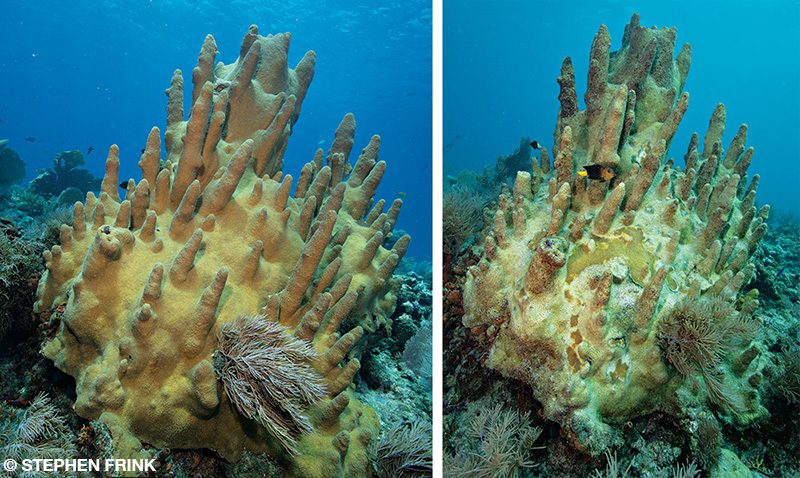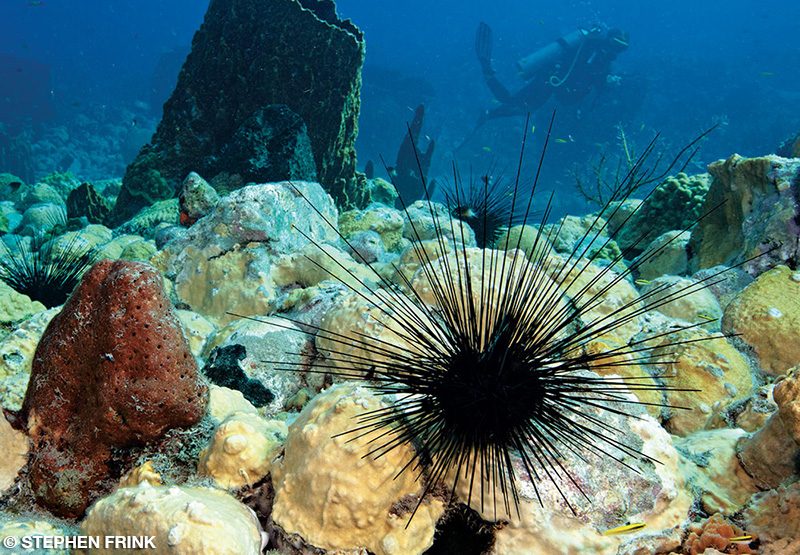The Coral-List, an online forum hosted by the National Oceanic and Atmospheric Administration (NOAA), recently had several interesting discussions about reef rehabilitation and transplanting. Proposed causes of reef decline are interesting and varied but not new: A recent list of coral health threats contained what I call “the usual suspects.” The only thing left off the list, however, was African dust, which periodically and simultaneously affects the entire Caribbean.
Dust, unlike the usual suspects, can affect small, isolated reefs where the usual suspects are absent, and these dust events have increased in recent years. While there have been few simple bioassays of dust effects on live corals, a high school student recently used African dust collected in dust traps in Florida for a science project. In controlled aquarium experiments, she found that all three of the different concentrations she tested killed staghorn coral (A. cervicornis) in about two days. The toxins in the dust that caused coral death, however, remain unidentified, as it was a simple proof-of-concept experiment.
Due to behind-the-scenes politics and lack of funding, university and government agency scientists have yet to test dust and other chemicals. Many reputable, qualified scientists have submitted proposals to test the toxicity of African dust, but all received rejections. It may require some motivated, self-funded scientists to do the needed experiments.
Incidentally, the high school student who did the dust experiment is one of three sisters, each of whom have won awards for high school science posters and who are the daughters of a geologist who recently headed the coral resource protection section at the Florida Keys National Marine Sanctuary. Their posters depicted coral research projects featuring controlled experiments on coral disease in the Florida Keys and the toxic effects of oxybenzone sunscreen and common mosquito sprays.
I served on many coral reef committees in the Keys beginning in the mid-1970s in which discussions focused on subjects such as anchor damage and boat groundings, which are easy to observe and photograph. There were no coral diseases in the 1950s and 1960s, so anchor damage always healed quickly, and there were far fewer boats on the water and lower numbers of visitors and activity in the area. That all changed in the late 1970s.

My simple calculation regarding the proliferation of staghorn coral following Hurricane Donna in 1960 shows that based on the annual growth rate and frequency of branching, a healthy staghorn colony consisting of 10 branches could potentially produce 35 miles of branches in just 10 years.1 That can never happen because growth of this shallow-water coral would stop when it reached sea level — there is not enough space for them to reach their full potential. They stopped growing in the late 1970s, with their demise peaking in 1983, primarily due to white-band disease, which affected corals in Florida and throughout the Caribbean. It has been a slippery slope downward ever since.
To my knowledge, there has been only one controlled laboratory study to determine the impact of sewage (wastewater) on corals in southeastern Florida. Using water from the Virginia Key sewage treatment plant in Miami-Dade County, the study showed that corals near the outfall were not directly affected, but algae grew fast and would interfere with coral growth if not manually removed. A researcher from the University of Miami Rosenstiel School of Marine and Atmospheric Science presented that paper in 1981 at the Fourth International Coral Reef Symposium in Manila, Philippines. The study happened before coral diseases appeared in the Caribbean and before the Diadema plague in 1983.
In the late 1980s we wondered if sewage in groundwater might be affecting coral growth in the Keys. With state and federal funding, we installed around 50 monitoring wells and measured the lateral movement of sewage-contaminated groundwater. We found that everywhere in the Florida Keys the net flow is toward the coral reefs. We had hoped the study would show that groundwater flow would correlate with coral diseases. If correct, improved wastewater treatment would have had a direct benefit to the corals. Unfortunately, our work did not prove corals were being affected by groundwater, even though it contained fecal bacteria and most everything else that goes into septic tank drain fields and disposal wells. That study helped to support the installation of a Keys-wide sewage system but did not prove sewage water was causing coral disease.

Coral diseases were breaking out around distant Caribbean islands, and corals were simultaneously suffering the same fate as those in the Keys. Because of these observations, we began to recognize there might be something else that could simultaneously affect the entire Caribbean and believed it was African dust. The red soils and reddish-brown crusts found on all Caribbean islands came via trade winds from North Africa. African dust transport peaked in 1983, which is the same year Diadema died, sea fan disease began and acroporid corals became diseased almost everywhere. Lake Chad in North Africa was drying up, and its lakebed was blowing away — it has shrunk by 90 percent since the 1960s.
Science can be a beautiful instrument, but various proprietary or political reasons often hold environmental studies in check and prevent the publication of results. Even though straightforward bioassays have not happened, the recent rash of funding for coral nurturing and outplanting has stimulated many detailed studies, including anatomy, DNA, pH, symbionts, temperature, nutrients and many other basics that otherwise might not have been considered important enough for funding.
We still do not know what ingredients in African dust kill coral, but let’s hope that the increased focus on coral health will bring funding for the research necessary to unravel the mystery of this threat.
Explore More
© Alert Diver — Q1 2020